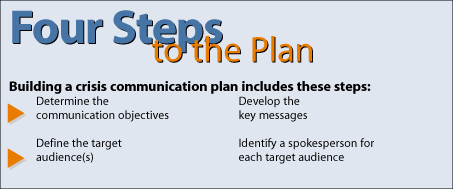The purpose of a crisis communication plan is to develop procedures for effective communication between internal and external stakeholders and the media during a crisis. The plan should also include procedures and policies for coordinating with external agencies such as law enforcement, fire service and emergency medical services.
Certainly, being prepared to respond to a crisis involves much more than training the leaders of your organization to interact with the media. One proven practice is to ensure that crisis communication plans are a coordinated part of the emergency response and business continuity plans.
Most crises are not discreet
A crisis in this context is defined as anything that affects the short or long term survival of an organization or has a negative outcome in regards to the organization’s reputation or brand. This type of crisis, such as a scandal or disaster, is never discreet; the public often knows about the event almost as soon as you do. A robust and exercised crisis communication plan that details how to manage communications can be the difference between preserving your organization’s credibility, reputation and revenue, or not. This capability needs to be in place before you need it.Obviously, the immediate objective of any crisis is to stem the impacts and effects of the problem itself. If there are injuries, see that everyone is cared for. If you’re facing a product defect, see that the faulty product is recalled, cleared from the shelves or otherwise retrieved from customers.
The next step is to begin communicating with those people affected by the crisis; tell them what happened, what plans you have in place, what your actions and focus is and what effect your problem has on them. Rapidly establishing communication with key stakeholders is a primary objective. It enhances the credibility of your organization and builds trust.
Depending on your industry, you may need to notify and communicate with regulators or special interest groups as well. Before problems occur, make the time to meet with external agencies that may be engaged in emergency response.

Get ready for stress
Your BCM planning efforts are intended to minimize chaos and confusion during a highly stressful and chaotic time. In a crisis or disaster, communication and coordination activities will be significant. There are enormous benefits to establishing relationships and beginning your planning efforts before a crisis occurs.When the unthinkable happens, everyone affected will want to know something. This is a very diverse group and challenges will abound. Audiences will range from the board room to the boiler room to the press room.
When a situation unexpectedly thrusts your organization into the spotlight, focus on the key message necessary for each of your target audiences. The key message needs to satisfy the unique requirements of each audience. They may vary in detail provided, but they should have a consistent theme, should support the objective, and be repeated constantly. Key messages provide tone, context and consistency for all additional messages. The point to remember is that the objective and key messages are constant, while the detail and delivery methods may vary dependent upon the audience.
The general public will generally learn of a crisis situation through the news media, which may or may not convey improper or distorted perceptions in order to generate interest. The less factual information that the media has to report, the more likely they are to misrepresent the situation. Keep the media as enlightened as possible; that way, they can be a resource for keeping the public accurately informed. In most crisis management scenarios, the outcome depends heavily on what the organization does or says in the first few hours. What the news media report in their first stories – and how they view your coping skills – will often set the tone for the entire crisis. Tell your story! Be honest. Be truthful.
When developing the media message, you should also identify the most appropriate spokesperson for each target audience. These spokespeople need to be trained to deliver the organization’s message in a consistent fashion. Consider retaining outside public relations expertise in your plan. It is often difficult during a crisis for internal resources to have the separation and objectivity necessary to effectively assess and craft the appropriate message.
Communication is a significant element of any BCM program and is one of the keys to success.


